MPN Newly Diagnosed Archives
Your MPN diagnosis is just a starting point. Even though the path ahead may seem unclear or even insurmountable, armed with knowledge you can take control.
Let us help you become empowered to understand your diagnosis, to confidently ask questions, and to identify providers that are the best fit for you.
More resources for Myeloproliferative Neoplasms (MPN) Newly Diagnosed from Patient Empowerment Network.
My Journey of Living With a Myeloproliferative Neoplasm for 30 Years
My Journey of Living With a Myeloproliferative Neoplasm for 30 Years from Patient Empowerment Network on Vimeo.
Myeloproliferative neoplasm patient Nona was shocked after diagnosis with two MPNs – essential thrombocythemia (ET) and polycythemia vera (PV) – at the age of 41. Watch as she shares her MPN patient journey over 30 years. Nona’s advice to other MPN patients, “Use your voice, you are not alone, make sure you establish a good relationship with your care team. You are truly your own best advocate!”
See More from Best MPN Care No Matter Where You Live
Related Resources:

|

|

|
Transcript:
Nona:
My name is Nona. I live in West Sussex, England. In 1991, I was diagnosed with essential thrombocythemia (ET) and then polycythemia vera (PV) in 1995, both myeloproliferative neoplasms (MPN). This came as a big surprise to myself and my husband. At the time, my care team said there were only 12,000 known patients in the UK living with my condition. At the time of my diagnosis, I was 41 years old, a wife, and a busy mother to three children as well as having a part-time job.
Prior to my diagnosis (with symptoms of painful feet, ulcers on my toes, and chronic tiredness), I was seen by three different clinicians. One doctor told me that my blood work had suggested that I had an alcohol issue and that I was somehow in denial. That really scared me, as I hardly drink alcohol. My research led me to nowhere at the time, as there was very little information about MPNs available. At that point in time, they were called blood disorders. When I read the leaflet with the prescription medication, it referred to treatment for cancer.
I went back to my primary care physician as I really felt very frightened and confused. I learned that MPNs were a proliferation of the blood cells, but not cancer in the conventional sense of the word – in other words, a chronic treatable disorder. Having lived with an MPN for over 30 years hasn’t always been an easy journey. But over the years, a more accurate early diagnosis and treatments have progressed beyond belief, and for that I am grateful. I have never forgotten the difficult feelings of anxiety and fear when I was first diagnosed.
In 2005, I had a second opinion from a respected MPN expert who started a charity, now called MPNvoice. The mission is to provide up-to-date, accurate information to both the medical and patient communities. I have been fully involved with the charity since then and now serve as co-chair reaching out to patients around the world.
My advice to other MPN patients: it’s important to remember everyone’s MPN journey is different and some patients struggle with more symptoms than others. Don’t let your MPN become your life if you can just see it as part of your life so that you can get on and live your life. Use your voice, you are not alone. Make sure you establish a good relationship with your care team. You are truly your own best advocate.
These actions are key to staying on your path to empowerment.
My MPN Journey, Getting the Best Care After ET and MF Diagnoses
My MPN Journey, Getting the Best Care After ET and MF Diagnoses from Patient Empowerment Network on Vimeo.
Myelofibrosis and essential thrombocythemia (ET) patient Julia had experience as a health educator and hospital administrator before receiving her MPN diagnosis. Watch as she shares how she later connected the dots from her symptoms and blood work, lessons learned about myelofibrosis patient journeys, and her advice for living well with MPNs.
Related Resources:

|

|

|
Transcript:
Julia:
My name is Julia, I was diagnosed with essential thrombocythemia in 2007, and then with myelofibrosis a year later, after routine blood work. The diagnosis came out of nowhere. I was healthy and active prior to my diagnosis and raising five children with my husband. I’ll never forget the day I received a voicemail from my primary care doctor’s office, I really couldn’t believe what I was hearing. I didn’t have time for this illness in my life. I had a bone marrow biopsy that showed I was positive for JAK2 and had a 5q deletion genetic mutation. I started on daily aspirin, and it was a hard pill to swallow for many reasons.
As a certified health educator and former hospital administrator, I understood the importance of treating a rare disease, but I had a difficult time with the idea of taking medicine daily, and I felt like I didn’t have any symptoms. I reviewed my old lab print-outs that showed elevated platelets 15 years before, that slowly increased over time. I recall having severe migraines that would put me out of commission for the day, and tenacious fatigue in the years before, I didn’t connect the dots with the symptoms, and neither did my oncologist. By 2007, my platelets and white blood cells were very high.
I decided to find an expert with extensive experience with ET and MF to get top-notch monitoring and treatment. I connected with a specialist for many years and hope to keep living with my disease for many years ahead. I’ve had several hospitalizations and ER visits over the years, but keep on going. MF has absolutely changed the path of my life and how I live it, but I still do most of what I want to do while I’ve been lucky in maintaining stable myelofibrosis with no true signs of disease progression or serious myelofibrosis complications, it’s important to understand the path for other myelofibrosis patients might be quite different.
My advice for others MPN patients is:
- Pay attention to how you feel and pace yourself.
- Keep track of your blood counts, so you can alert your care team.
- Find an MPN specialist for your care.
- Don’t forget to be present and spend time with your family.
These actions are key to staying on your path to empowerment
What MPN Side Effects Can Be Monitored With Telemedicine?
What MPN Side Effects Can Be Monitored With Telemedicine? from Patient Empowerment Network on Vimeo.
For myeloproliferative neoplasm (MPN) patients, what are some side effects that can be monitored via telemedicine? Expert Dr. Jamile Shammo from Rush University Medical Center shares the types of symptom monitoring that can be carried out virtually – and shares a specific piece of MPN monitoring that she recommends be performed regularly in-person for ideal care.
See More From the MPN TelemEDucation Resource Center
Related Resource:
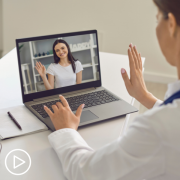
|

|
Transcript:
Dr. Jamile Shammo:
MPN patients can be monitored remotely because clearly, a big part of their monitoring relates to symptom assessment, and so there are certain symptom assessment forms that we would do in the clinic just as well as we will do online or via virtual visits. So these can be done, again, when two people are speaking to one another, so granted these have to be performed, and then like I said, talking about the labs would also be done in a virtual fashion, the only piece that is missing, like I said, would be the physical exam, for that reason, I feel like that part has to be assessed at certain intervals that would have to be determined by the treating physician, but symptom assessments is a very big case of taking care of patients who have MPN. That certainly can be done virtually.
An MPN Expert’s Top Three Tips for a Telemedicine Visit
An MPN Expert’s Top Three Tips for a Telemedicine Visit from Patient Empowerment Network on Vimeo.
As a myeloproliferative neoplasm (MPN) patient, what steps can be taken to prepare for telemedicine visits? Expert Dr. Jamile Shammo from Rush University Medical Center provides her key tips to help ensure an optimal telehealth visit.
See More From the MPN TelemEDucation Resource Center
Related Resource:

|
Transcript:
Dr. Jamile Shammo:
When preparing for a televisit, I think it’s so important to know whether or not you would have a connectivity issue. A lot of times I’m trying to connect with the patient and then we realize that their phone isn’t equipped to handle the televisit and that is kind of disappointing to find that out a minute before you try to connect then that visit becomes a telephone encounter, which is again, less satisfying for some patients. I mean it does the job, but again, it doesn’t provide me with the exam…part of the exam that I’d like to do, at least in that way. So, I think prepare yourself and make sure that your device is able to connect and actually most clinics will have a person that may be able to help you navigate through the televisit pieces that would help you get through and connect with the provider, and then obviously with an MPN or any other visit, patient with a heme malignancy, it would be helpful to make sure that you have a blood draw or if your physician would like to have a blood draw in my case, I always like to have a CBC beforehand or perhaps a chemistry or maybe ion studies or what have you, to have that so that there will be something to discuss and make sure that your physician has had those results before you have the visit.
Sometimes it is also disappointing that the patient thinks I’ve received those results when I actually haven’t and I have no control over that, so that would be the other piece. All of us do our best so that we can make sure that all those pieces are in place so that we can conduct the visit. And I know it’s a lot of work on everybody’s part. But in the end, what matters is that we are providing the best care possible in those very challenging times.
What Opportunities and Challenges Does Telemedicine Present for MPN Patients?
What Opportunities and Challenges Does Telemedicine Present for MPN Patients? from Patient Empowerment Network on Vimeo.
For myeloproliferative neoplasm (MPN) patients, what does telemedicine offer in terms of opportunities and challenges? Expert Dr. Jamile Shammo from Rush University Medical Center shares situations when telemedicine versus in-person visits can help provide optimal MPN patient care.
See More From the MPN TelemEDucation Resource Center
Related Resource:

|

|
Transcript:
Dr. Jamile Shammo:
I think the medicine has provided a tremendous opportunity for us to take care of patients in general, MPN patients in particular during the pandemic. We obviously wanted to minimize the exposure of patients to COVID during the pandemic, but patients who have MPN as well as other hematological malignancies needed to have CBCs frequently to make sure that the treatments that they were on were safe, that they were doing what they were supposed to do in terms of controlling their counts. So, then there was no escaping that. And they also needed to get ahold of their doctor, so being able to do both, perhaps away from the hospital in some type of clinic and being able to connect with the physician online to discuss the results of the CBC that they had obtained in perhaps a less populated lab was tremendous. And granted, this had made it feasible to care for patients during the pandemic. But now that we are sort of emerging from the pandemic, people are realizing that perhaps those technologies are there to stay, and perhaps there’s a subset of patients that may still be able to benefit and take advantage from those resources, so we are learning as we go who may be able to continue to do this.
I have to say though, that that may not be for every patient, and I still feel like there’s a particular type of MPN patient that will benefit from seeing the physician and having a full exam once every so often. And we can talk about the particular application that that may be, but granted telemedicine has certainly provided a tremendous advantage during COVID.
So, when I think of the patient that might benefit most from seeing the physician via televisit, for example, it would be someone who perhaps has a stable disease. Someone who I may want to monitor perhaps every three to six months, someone who may have stable counts, and we’re just talking to about their symptoms and monitoring those types of things every so often. And perhaps I look at the labs and you can discuss their symptoms and whether or not they have splenomegaly and issues like that. Someone who may already be on a stable dose of medication and we don’t have to do any dose adjustments and even if we have to do those adjustments, perhaps we could do labs a little more frequently, so that would be all right too, but someone in whom I would like to initiate in treatment, someone in whom the disease may be progressing a little too quickly, someone who I may want to do an exam and assess their spleen, I suppose you could send them to an ultrasound facility and obtain an MRI or a CT, or an ultrasound of the imaging study that is. But there’s nothing like an actual exam of the patient. You are thinking about the disease progression, so those sorts of patients in which the disease is actually changing its pace, you may want to take a look at it, the full smear look and examine the skin for certain TKI and signs and symptoms of low platelets and that sort of thing. Look in the mouth for ulcers and things of that nature. Those are the patients that I feel like would benefit the most from seeing their physician of course, the patient who has questions and that that could be probably beyond what a televisit could do. I think those would be the types of situations where you would like to have a physical presence and discuss things that would be of extreme importance to the patient’s physical health, psychological health, and of course, labs that you may want to obtain beyond the regular CBC that a standard lab could obtain outside of your institution. There are specialized labs that not every leg outside of your own tertiary care center may be able to provide, and that is something that we need to all the time. Let’s say a patient may require a bone biopsy, well then you have to have them physically be in your place, and then you might as well, then see them, examine them and do all of the labs, and that’s the other thing that we would like to do is perhaps to bundle all of the tests that you would be minimizing the exposure of patients to frequent visits so that you would be again, lessening the exposure, potentially infections.
What Impact Does Telemedicine Have on Clinical Trials for MPN Patients?
What Impact Does Telemedicine Have on Clinical Trials for MPN Patients? from Patient Empowerment Network on Vimeo.
For myeloproliferative neoplasm (MPN) patients, what impact does telemedicine have on clinical trial access? Expert Dr. Jamile Shammo from Rush University Medical Center explains the current environment for clinical trial access and her perspective on how trial access should be approached in the future for improved MPN care.
See More From the MPN TelemEDucation Resource Center
Related Resource:

|

|
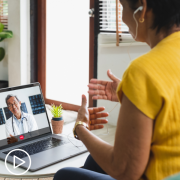
|
Transcript:
Dr. Jamile Shammo:
So, there’s no doubt that COVID has certainly impacted our ability to enroll patients on clinical trials. There have been a lot of governing bodies that have created various rules and regulations around that to facilitate enrolling patients on clinical trials, and I think right now we are seeing that this has become feasible, such that we are able to enroll patients yet again on the clinical trial. So, now I think that we have the vaccine that is available, it has become a little bit more feasible and possible to do so. So, this should not stop us. I think we should continue to seek better treatments for MPN patients actually the only way to do so is by you know, only patients on trials, because we certainly don’t have a perfect way to provide care at the moment, we always need to come up with better ways and that would be one way to do so.
The MPN community truly should partner with their physician and learn as much as possible about their disease and about available treatment options, and perhaps show some support for available clinical trials because this is the only way that we can perhaps understand how we can do a better job in treating patients who have MPNs.
NCCN Guidance on Safety and Effectiveness of COVID-19 Vaccines for Cancer Patients
NCCN Guidance on Safety and Effectiveness of COVID-19 Vaccines for Cancer Patients from Patient Empowerment Network on Vimeo.
Is the COVID-19 vaccine recommended for people living with cancer? Dr. Erin Roesch shares recommendations from the National Comprehensive Cancer Network (NCCN) for those undergoing cancer treatment, including guidance on mask wearing and advice for family members.
Dr. Erin Roesch is a breast medical oncologist at the Cleveland Clinic. Learn more about Dr. Roesch here.
Transcript:
Katherine:
Many cancer patients have questions about the COVID vaccine. Is it safe? Do we need to continue wearing masks? Here to address these questions is cancer expert, Dr. Erin Roesch. Dr. Roesch, would you introduce yourself?
Dr. Roesch:
Hello. And thank you for inviting me to participate in this very important conversation. My name is Erin Roesch. I am a breast medical oncologist at Cleveland Clinic.
Katherine:
Excellent. Thank you so much for joining us today. I’d like to run through a list of concerns that cancer patients have about vaccines in general and the COVID vaccine specifically.
So, let’s start with a basic question. Should people get vaccinated if they have cancer?
Dr. Roesch:
Yes. All individuals diagnosed with cancer should get the COVID-19 vaccine as recommended by the National Comprehensive Cancer Network or NCCN.
An immunocompromised state makes many people with cancer at higher risk of serious COVID-19 illness. Those who are vaccinated are less likely to become sick with COVID-19. And, also, vaccinated people who do get COVID-19 are much less likely to become seriously ill.
I would also mention that those living in the same household as a person diagnosed with cancer and caregivers or other close contacts should also get vaccinated.
Katherine:
Another common question is whether people with cancer should wait for any reason to get the COVID-19 vaccine.
Dr. Roesch:
Most people with cancer should get the vaccine as soon as they can with a few exceptions according to NCCN.
People in the process of receiving stem cell transplant or cellular therapy should wait at least three months after they finish treatment to get vaccinated.
Those diagnosed with certain forms of leukemia should also wait a few weeks after receiving treatment to allow their immune system to recover so the vaccine can be effective.
It’s not been clearly defined exactly how chemotherapy affects responses to COVID-19 vaccines. But some data suggests that immune responses may not be as robust. However, it is still recommended that those receiving chemotherapy and also immunotherapy and radiation should get vaccinated whenever they can.
Katherine:
I think a lot of people are concerned too about whether one vaccine is better than another. What would you say to them?
Dr. Roesch:
And that is a common question that I often get in my clinic. And I advise my patients to receive or take whatever vaccine they are offered.
We don’t really have any studies or data at this point suggesting one being better than another in cancer patients.
Katherine:
Some people are wondering if the vaccine can give a person COVID-19. How would you address that?
Dr. Roesch:
I would say that as none of the currently available vaccines are made with a live virus, the vaccine itself can’t give a person COVID-19. By getting vaccinated, actually, those who are immunocompromised are really helping society to prevent the spread of COVID-19. Immunocompromised people who get COVID-19 may be more likely to infect others due to prolonged shedding of the virus after infection.
Katherine:
What about side effects? Are the vaccine’s side effects worse for people with cancer?
Dr. Roesch:
No. Side effects do not appear to be worse for those diagnosed with cancer. Results to date suggest that the vaccine’s side effects in people with and without cancer are really no different.
These side effects, as we have seen, may include arm soreness, rash, fatigue, chills, fever, headache, for example.
Katherine:
And, finally, can cancer patients stop wearing a mask after they’ve been vaccinated?
Dr. Roesch:
Cancer patients should continue to wear a mask post-vaccination. Many people with cancer may have a harder time actually fighting infections and may not respond as well to vaccines. So, people diagnosed with cancer and their close contacts should get vaccinated and then continue to follow precautions, which include wearing masks, social distancing, hand hygiene.
Katherine:
Is there a certain length of time that people need to continue wearing a mask after being vaccinated?
Dr. Roesch:
At this time, I would recommend patients continue to follow the CDC guidelines that are currently in place. And at this point, I don’t think we have a projected end time for that yet.
Katherine:
Is there anything else you’d like to share with cancer patients who may be concerned about vaccinations?
Dr. Roesch:
I would encourage those diagnosed with cancer to not only themselves get vaccinated but to also really voice and stress the importance of vaccination to those that surround them, including, again, members of their household, close contacts, and even beyond their inner circle.
I would also advise people to try and avoid letting the concern of possible side effects related to the shot deter them from getting it. The symptoms of COVID-19 can be much worse and potentially serious for some compared with the relatively minor side effects that we’ve seen with the vaccine itself.
I also would mention I’ve had personal patients that have expressed concern about functioning of their immune system while receiving chemotherapy and how this might affect their response to the vaccine. I do emphasize to them that even though responses might not be as strong as they may be in the absence of active treatment, I feel like the potential benefits of the vaccine still outweigh the risks in my mind.
Katherine:
Thanks so much for joining us today, Dr. Roesch.
Dr. Roesch:
Thank you for having me.
MPN Caregivers: How to Provide Support During Appointments
MPN Caregivers: How to Provide Support During Appointments from Patient Empowerment Network on Vimeo.
How can myeloproliferative neoplasm (MPN) caregivers provide support during office visits? Dr. Naveen Pemmaraju shares key advice for caregivers to help improve and increase communication with healthcare providers for the sake of their loved one.
Dr. Naveen Pemmaraju is Director of the Blastic Plasmacytoid Dendritic Cell Neoplasm (BPDCN) Program in the Department of Leukemia at The University of Texas MD Anderson Cancer Center. Learn more about Dr. Pemmaraju, here.
Related Programs:
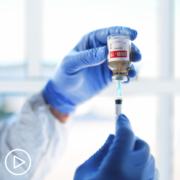
Is the COVID-19 Vaccine Safe and Effective for MPN Patients? |

|

What Are the Considerations When Choosing Myelofibrosis Therapy? |
Transcript:
Katherine Banwell:
Well, we have another audience question. This one is from Richard. He wants to know what advice do you have for caregivers, and how can he be supportive during appointments?
Dr. Pemmaraju:
Yeah. Richard’s question really is so important. Really, before the pandemic and now with the pandemic this extended time, this is the most important question that’s coming up. This is a challenge. I think a lot of our patients who are older, frail, live alone, they don’t even have the option to do that. That may be 25 percent of our patients right there,
And that’s very heartbreaking and difficult, and clearly, their care – it may not be compromised, but it’s certainly limited in some ways without getting that other perspective. Right? So, I think that’s important.
Now, out of the 75 percent of the people who may have someone that can be a part of their life, a lot of these folks, Katherine, are limited because of the pandemic. Most hospitals, smartly, I think, still have restrictions on not allowing every single person in the building just for health and safety protocols. So, telehealth has had to be a substitute, I would say, for that, and in a lot of cases, has been helpful. In some cases, frustrating, obviously, with technical difficulties, etcetera, etcetera.
I would say that the key is – and I really want this to be very specific. It would be easy to just say, “Yep, bring a loved one to your visit.” No, it’s not that easy, right? So, now, during the pandemic, I think two things are very important and what I’ve noticed. One is, if the patient is able to, if their health allows them to, prime the loved one or caregiver, “Hey, I’m going to be in the doctor’s office from this time.”
And I always say make it like the cable person visit, right? From 8:00 to 5:00. So, “Hey, today, on Tuesday, if you can have your cell phone on you, that would be nice, because I’m going to patch you in, and you can listen in the background.” This is actually a key pearl I can give to people. You’d be surprised how helpful that is. Because most people, if they’re not living in the same household or whatever – “Oh, I didn’t even know you were going to be – okay.”
Number two, when the loved one or caregiver is involved, which I encourage for everyone, try to discuss with them the night before, if your health allows you to, to go over some of the key questions. Say, “Hey, guess what? I only understand about 7 to 10 percent of what goes on in these visits, but I need you to ask this.” So, you can kind of prime your loved one to do that.
And then, lastly, you had mentioned earlier to have this list of questions. Well, that’s a great thing to give to the caregiver, right? So, if you’re able to use email and your family member is in California and you’re in Texas, maybe a quick email the night before.
“Hey, here’s what I’m thinking. In case I forget, will you ask this to the doctor?” A lot of these visits may only be five or 10 minutes, but you’d be surprised, if you have a list of two or three questions – boom, boom, boom – and then it’ll alleviate those worries there.
Lastly, I would also say don’t feel – I want to tell this to the viewers out there. Don’t feel pressured when you’re in the visit with us that you have to get every single thing out. And what I mean by that is now with email and the electronic medical record portal systems, there is some ability to contact people during – I’m sorry, after and between visits. So, maybe that might help you to not feel so much pressure in the visit.
Expert Advice for Learning About Your MPNs Online
Expert Advice for Learning About Your MPNs Online from Patient Empowerment Network on Vimeo.
How can myeloproliferative neoplasm (MPN) patients safely learn about their condition online? Dr. Naveen Pemmaraju offers key tips for finding credible information and how to process MPN information with members of your care team.
Dr. Naveen Pemmaraju is Director of the Blastic Plasmacytoid Dendritic Cell Neoplasm (BPDCN) Program in the Department of Leukemia at The University of Texas MD Anderson Cancer Center. Learn more about Dr. Pemmaraju, here.
Related Programs:

|

Is the COVID-19 Vaccine Safe and Effective for MPN Patients? |

How to Play an Active Role in Your MPN Treatment and Care Decisions |
Transcript:
Katherine Banwell:
Dr. Pemmaraju, you’re very active on social media, and patients often share information with one another. So, what advice do you have for patients to ensure online sources are actually credible?
Dr. Pemmaraju:
Wow, great question. First thing I would say is I encourage everyone to get out there. so, that’s key opinion leaders, local physicians, nurses, pharmacists, patients, caregivers, everyone. But Part 2 is what you said is true. Most everything out there is noise. It could be garbage. It could be background. It could be misinformation. So, you do have to have some way to filter it.
I call it signal from the noise. That’s a common phrase that a lot of people on social media use. I guess three things that I would give as tips. One is don’t be afraid to read and get on there, but I would just say whatever you read, take it with a grain of salt, as you said, and just write everything down where you have it organized.
Number two, tend to gravitate towards known experts and known sources. So, for example, you mentioned that I’m on there. That’s great. Ruben Mesa, our great friend and colleague, etcetera, etcetera. So, if you know who the 10 or 15 thought leaders are on Twitter or social media, see what they’re saying directly. That’s nice because it’s straight from them to the public.
And then three is stick with the organizations and entities that are trusted sources. New England Journal of Medicine, ASCO, ASH, programs such as yourself, etcetera, etcetera, who are trying to put out there the latest and honest information.
Okay. So, now the fourth part, though, I think is the most important, which is what we said earlier, which is whatever you look up, discuss it with your doctor and your physician team. Period. Because no matter what research you did, no matter what patients groups you join, there might be something that either doesn’t apply to you, or worse, as you said, it could be actual misinformation, and it’s a red herring.
So, maybe find information, figure out a way to filter it, crosscheck it, and then bring it up to your doctor team. I think that’s a winning way for success with information nowadays.
Why You Should Speak Up About MPN Symptoms and Treatment Side Effects
Why You Should Speak Up About MPN Symptoms and Treatment Side Effects from Patient Empowerment Network on Vimeo.
Why should myeloproliferative neoplasm (MPN) patients speak up about symptoms and treatment side effects? Dr. Naveen Pemmaraju explains the importance of reporting any issues you may be experiencing to ensure the best care for you.
Dr. Naveen Pemmaraju is Director of the Blastic Plasmacytoid Dendritic Cell Neoplasm (BPDCN) Program in the Department of Leukemia at The University of Texas MD Anderson Cancer Center. Learn more about Dr. Pemmaraju, here.
Related Programs:

|

|

|
Transcript:
Katherine Banwell:
Why is it so important for patients to speak up when it comes to symptoms or treatment side effects?
Dr. Pemmaraju:
Well, I’m going to be that magician who you watch the TV show, they give away all the secrets. So, this is the big secret. Your doctor cannot read your mind. I hate to say that, Katherine. I just said it here, and it’s going to surprise some people. No, I mean, seriously. Right. So, I think the problem with the MPNs – not the problem, the caveat, the difficulty – is if you are a patient, you have this war that’s suffering inside of you. I know that as an expert person. You know that as a patient. But whoever you’re sitting in front of is not going to know that.
And there are two reasons for that. One is you don’t look like that. Most of our patients – whatever this is, I’m going to put this in big air quotes, so in case someone’s not watching this and they’re only hearing, I’m putting air quotes. People say to my patients, “Wow, you don’t look like a cancer patient.” Whatever that means, right? So, most of our patients don’t have their hair falling out, etcetera, etcetera. So, there’s that aspect of it, the visual education part of it.
Then there’s also the part, which is a lot of these symptoms burdens are not obvious on the physical exam. You cannot tell by talking to someone or looking at them if they have night sweats, bone pain, even itching, any of these things. Fatigue. You can’t tell if someone has fatigue most of the time unless you ask them. So, this is one of those where shared partnership in decision-making is not just a generic phrase. This is important.
I would say that for a patient with an MPN, the MPN symptom burden – the questionnaire, the 10 questions that we now have settled on – that can tell so much more or as much as the physical exam or the blood counts.
So, it’s imperative. It’s not just a luxury. It’s imperative. And if the patient themselves is unable to speak up, then if the advocate or caregiver or loved one can, if that person is available.
The other point I would say to this is that oftentimes the symptoms can precede – they can come before laboratory changes, physical exam changes, all these things. So, a constant, constant communication, “Hey, I was playing 18 holes of golf last year.”
“Now I can’t even get out of bed.” Hello? That tells you more than almost anything you can read on a piece of paper. So, you, as always, are spot on with what you said. And this is the case where people say, “What can I do to help my care?” This is it. Speak up, speak out. It’s your body, it’s your life, make sure you feel empowered to do that.
How Is MPN Treatment Effectiveness Monitored?
How Is MPN Treatment Effectiveness Monitored? from Patient Empowerment Network on Vimeo.
How is the effectiveness of MPN treatment determined? Dr. Naveen Pemmaraju describes key factors to monitor treatment effectiveness to ensure optimal patient care and to determine when it may be time to consider a change in therapy.
Dr. Naveen Pemmaraju is Director of the Blastic Plasmacytoid Dendritic Cell Neoplasm (BPDCN) Program in the Department of Leukemia at The University of Texas MD Anderson Cancer Center. Learn more about Dr. Pemmaraju, here.
Related Programs

|

|

COVID-19 Vaccination: What Do Myelofibrosis Patients Need to Know? |
Transcript
Katherine Banwell:
Once on therapy, how is the disease monitored and how do you know if the treatment is working?
Dr. Pemmaraju:
So, it differs from each disease, but let’s take polycythemia vera for a good example. So, let’s suppose you have polycythemia vera. I think there’s three markers here that you can check. One is the blood counts, right?
So, you want to make sure that the blood counts are controlled. New England Journal, five or six years ago now, our Italian colleagues published a very seminal paper which shows that the goal of therapy should be that the hematocrit should be below 45. So, that’s actually a very nice number to have. So, not just waiting for symptoms of the disease but keep the number low. And if you do that, that correlates with decreased cardiac events, thromboembolic events.
Number two, I think that, besides the blood count, the spleen. The spleen and liver size also is a nice surrogate for how the disease is doing. So, if that’s enlarging or getting out of control, that may be time to stop what you’re doing, reassess. The disease may be progressing to myelofibrosis, for example.
And then I think, lastly, the absence of stuff actually helps, too. So, the absence of major bleeding, the absence of blood clots, the absence of transformation to MF. I think if the quality of life is good, you’re decreasing blood clots and bleeding, you’re not going to a more advanced disease state, these are all wins for us with P vera.
Katherine Banwell:
You touched on this briefly, but I’m wondering when a patient should consider changing treatments.
Dr. Pemmaraju:
Yeah, changing treatments is more art than science, I would say. So, it does – that’s one of those that is kind of specific from patient to patient. In general, what we just talked about gives you that guidance. So, in polycythemia vera, since we brought that up earlier, uncontrolled blood counts despite maximum medication intervention, the phlebotomy requirement being untoward and impossible to keep up with, the spleen size growing out of control, the quality of life being impossible – these are some aspects to look into changing therapy and/or clinical trial.
But remember, it’s not a one-size-fits-all, right? So, some patients, the counts – some of these things may or may not actually play out. So, it has to be more of a gestalt, more of a total picture there.
What Can MPN Patients Expect When Starting a New Treatment?
What Can MPN Patients Expect When Starting a New Treatment? from Patient Empowerment Network on Vimeo.
What can myeloproliferative neoplasm (MPN) patients expect when starting a new treatment? Dr. Naveen Pemmaraju shares advice about potential issues that can occur and key points to discuss with your pharmacist to ensure optimal care.
Dr. Naveen Pemmaraju is Director of the Blastic Plasmacytoid Dendritic Cell Neoplasm (BPDCN) Program in the Department of Leukemia at The University of Texas MD Anderson Cancer Center. Learn more about Dr. Pemmaraju, here.
Related Programs
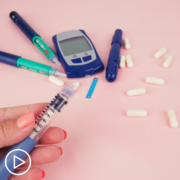
|

Why You Should Speak Up About MPN Symptoms and Treatment Side Effects |
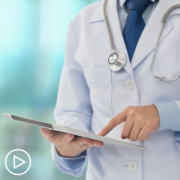
Expert Perspective: Promising Myelofibrosis Treatment Research |
Transcript
Katherine Banwell:
We have a question from a newly diagnosed PV patient. Sharon says, “I’m just about to begin Jakafi. What can I expect?”
Dr. Pemmaraju:
Yeah, great question, right? So, with ruxolitinib or Jakafi, I think the biggest couple of points here is, for what’s known, this is the first-in-class JAK inhibitor that we have the most experience with.
So, now we have over a decade-plus of experience. I guess general things are general, right? This is not specific medical advice. That’s not the intention of this program. But, in general, I would stick with what’s on the package label insert, and there are a couple things we know.
One is this is a highly effective drug. This drug, which we have tested now in multiple, multiple, multiple different trials in myelofibrosis, polycythemia vera, now approved in a form of graft-versus-host disease, different doses. So, I would say check the dose for your particular disease and indication. Double-check it with your pharmacist. Make sure there are no drug-to-drug interactions.
Number two, I think what’s important is that some patients on this drug can experience immunosuppression. So, that means that you may be at risk for some infections, and there’s some nice literature about that.
So, check with your doctor about that, particularly reactivation of old infections, looking out for viral infections, such as herpes zoster or shingles. And then I think the other key here is to watch out for the modulation of your disease. So, a lot of folks have big spleens, Katherine. Those shrink down. Then patients get their appetite back, they’re able to eat, and so some people can have weight gain that then goes the other way. So, these are some of the things you want to watch out for.
But, in general, read the package insert. If you have the ability to, it’s worth reading the – if you can, read the paper, right? Go read the New England Journal paper or – if you can look at that. And then make sure you talk to your local pharmacist and ask the same question there. You might be surprised at some tidbits and pearls you can pick up.
MPN Treatment: What Is the Role of Biomarkers?
MPN Treatment: What Is the Role of Biomarkers? from Patient Empowerment Network on Vimeo.
What role do biomarkers take in myeloproliferative neoplasm (MPN) treatment? Dr. Naveen Pemmaraju defines biomarkers and explains how molecular mutations play into MPN disease risk levels and treatment options.
Dr. Naveen Pemmaraju is Director of the Blastic Plasmacytoid Dendritic Cell Neoplasm (BPDCN) Program in the Department of Leukemia at The University of Texas MD Anderson Cancer Center. Learn more about Dr. Pemmaraju, here.
Related Programs

|

|

What Are the Considerations When Choosing Myelofibrosis Therapy? |
Transcript
Katherine Banwell:
Dr. Pemmaraju, let’s talk about biomarker testing. Can you help us understand what biomarkers are and how they may affect treatments?
Dr. Pemmaraju:
Yes. Biomarkers – I think that word gets mentioned a lot with really no definition, because it’s one of those words that can be whatever someone wants it to be. So, you’re right. For us, it’s a very important word in MPN. Bio meaning of life, scientific, and then marker meaning some kind of a measuring stick that has a value.
Well, there are two ways to look at biomarkers. One is the obvious, which is we have the defined big three molecular mutations. So, that’s JAK2V617F, followed by CALR mutation, followed by MPL.
Those are the big three. Those make up about 90 percent of all patients with MPNs. You’re technically not born with them, although new data suggests that you may acquire these mutations right after birth. So, those markers are important because they can be used to diagnose the disease, right? Particularly in the challenging patient. They have high platelets, you can’t tell if it’s reactive or ET. Okay, so they’re helpful with diagnosis.
Maybe some studies have shown that some of these markers can be predictive, Katherine, of blood clots. Let that research be ongoing. And then, obviously, some of these may be helpful in terms of designing the future treatments, particularly targeted therapies. So, I think biomarkers are part of our field, if you look at it that way, at diagnosis and risk stratification prognosis. But there are other factors that are starting to come out. One is there are molecular mutations outside of these big three.
So, outside of JAK2, CALR, and MPL, that are very important actually. Not everyone is checking for them. They are ASXL1 mutations, EZH2, IDH1 and 2, so on and so forth.
So, these are extended molecular markers that can be checked at some doctors’ offices that now, in the latest scoring systems, if you have one of those or more than one or two, they can elevate your risk score. So, if you have low risk or intermediate risk myelofibrosis, they may make you intermediate or high risk.
So, that may be a bit more complicated than what most people are aware of. But just so you know, there are markers that can be readily checked that can tell if your disease may be a bit higher risk than we though, say, 10 years ago.
I think other biomarkers that we look at are some of the labs that are just the regular labs that are on almost every panel, but they can tell a lot about the disease. There’s the LDH, lactate dehydrogenase. There are several markers, such as CRP and sed rate.
So, anyway, there are a lot of labs that we can check depending on where you are in your disease state that can kind of tell us a lot about how inflamed you are, how active your disease is at the moment, and then that will lead to further confirmatory tests. So, I think, yeah, in general, this is an active, developing area of research in our MPN field.



